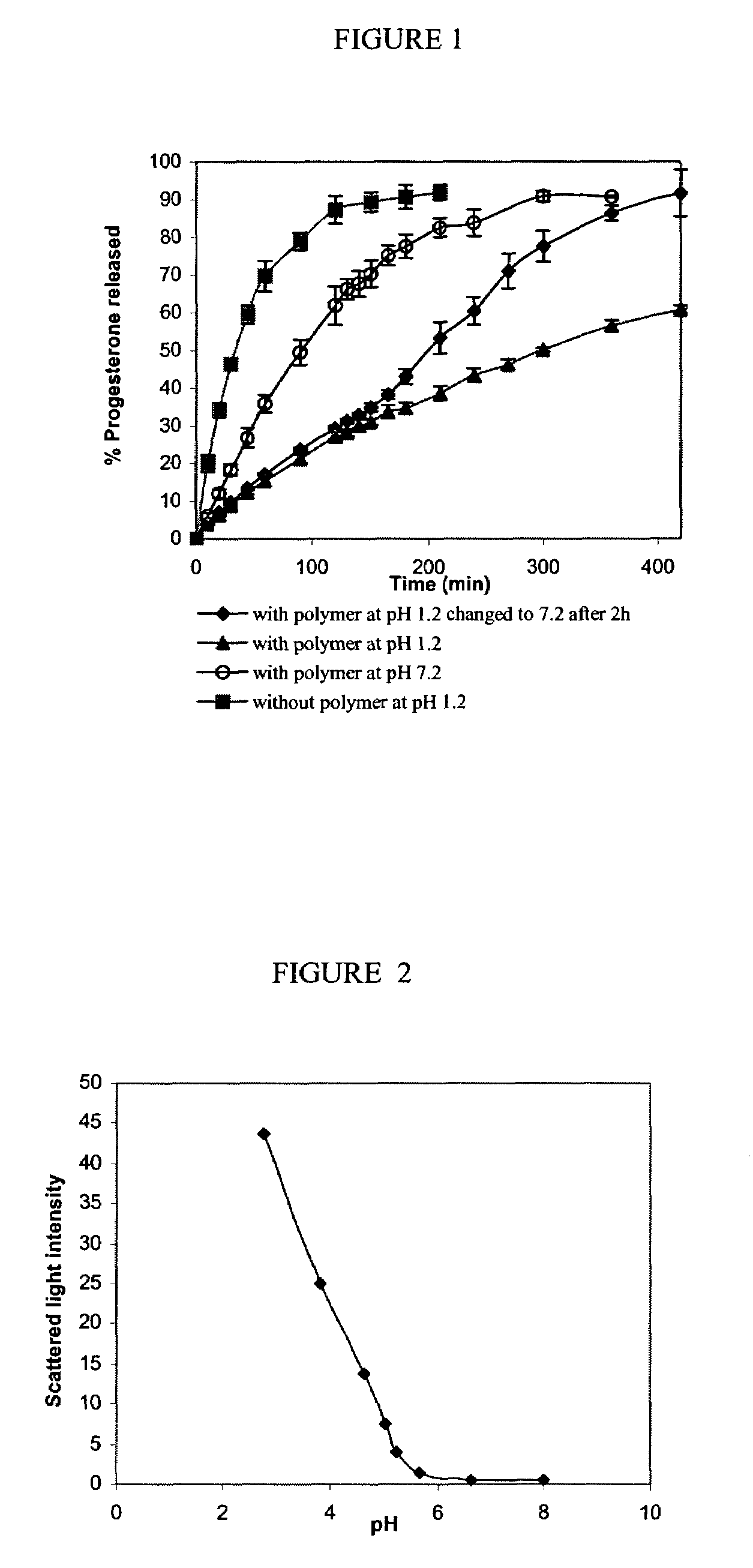pH-sensitive block copolymers for pharmaceutical compositions
- Summary
- Abstract
- Description
- Claims
- Application Information
AI Technical Summary
Benefits of technology
Problems solved by technology
Method used
Image
Examples
example 1
In Vitro Release of 3H-progesterone from PEO-b-poly(nBA50-co-MAA50) Supramolecular Assemblies at Different pH:
[0044]Progesterone was used as a model hydrophobic drug to evaluate the effect of pH on drug release from supramolecular assemblies. 3H-progesterone was loaded in the supramolecular assemblies of PEO-b-poly(nBA50-co-MAA50) of molecular weight 5300 Da by film casting method. Briefly, 10 mg polymer, 1 mg progesterone and 1 μCi 3H-progesterone were dissolved in a mixture of dichloromethane, ethanol and water in a scintillation vial. The solvents were evaporated under reduced pressure to cast a film of polymer and drug on the glass surface. The film was hydrated with water to obtain the supramolecular assemblies, this solution was filtered through 2 μm filter to remove precipitated drug.
[0045]For in vitro release study, the solution of progesterone loaded supramolecular assemblies was filled in a dialysis bag (6000–8000 Da molecular weight cut off) and the bag was put in a beake...
example 2
Bioavailability Studies of Fenofibrate Entrapped in Supramolecular Assemblies upon Oral Administration to Rats
[0049]Fenofibrate (FNB) was used as a model poorly water-soluble hydrophobic drug to evaluate the effect of drug incorporation in supramolecular assemblies on the bioavailability upon oral administration to rats. In a series of experiments, FNB incorporation was studied in different PEO-b-poly(EA-co-MAA) and PEO-b-poly(nBA50-co-MAA50) polymers by emulsion and film casting methods. The FNB loading was higher in PEO-b-poly(nBA50-co-MAA50) polymers. Therefore these polymers were used to evaluate relative bioavailability of FNB loaded supramolecular assemblies in Sprague-Dawley rats.
[0050]The study was conducted on 3 fenofibrate formulations, namely FNB supramolecular assemblies, FNB standard formulation and resuspended FNB. FNB loaded supramolecular assemblies were prepared from PEO-b-poly(nBA50-co-MAA50) of about molecular weight 5300 Da by film casting method. Size of the sup...
example 3
Formation of Polyion Complex Micelles of PEO-b-P(nBA50-co-MAA50) with poly-l-lysin
[0053]Poly-l-lysine (PLL) of molecular weight 16,100 was used as a model cationic compound for formation of polyion micelles with PEO-b-P(EA50-co-MAA50) and PEO-b-P(nBA50-co-MAA50) copolymers with molecular weights of 5100 and 5700 Da, respectively. Polymer: PLL (− / +) charge ratios (mole: mole) of 1:1 and 2:1 were used for complex formation. Stock solutions of polymer and PLL (molecular weight 16,100) having concentration of 2.5 mg / mL were prepared in phosphate buffer (pH 7.4) and mixed at room temperature to obtain 1 mg / mL final polymer concentration. The solution was filtered through 0.2 μm filter and size measurements were performed at 25° C. using dynamic light scattering (DLS). The results are shown in Table 1.
[0054]
TABLE 1Size of different polymer: PLL polyion micellesChargeDiameter%ratio(nm)Popu-PolydispersityPolymer(mol / mol)mean ± SDlationMean ± SDPEO-b-P(EA50-1:11049 ± 170 650.571 ± 0.199co-M...
PUM
| Property | Measurement | Unit |
|---|---|---|
| Mass | aaaaa | aaaaa |
| Size | aaaaa | aaaaa |
| Composition | aaaaa | aaaaa |
Abstract
Description
Claims
Application Information
 Login to View More
Login to View More - R&D
- Intellectual Property
- Life Sciences
- Materials
- Tech Scout
- Unparalleled Data Quality
- Higher Quality Content
- 60% Fewer Hallucinations
Browse by: Latest US Patents, China's latest patents, Technical Efficacy Thesaurus, Application Domain, Technology Topic, Popular Technical Reports.
© 2025 PatSnap. All rights reserved.Legal|Privacy policy|Modern Slavery Act Transparency Statement|Sitemap|About US| Contact US: help@patsnap.com


